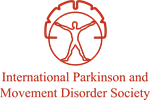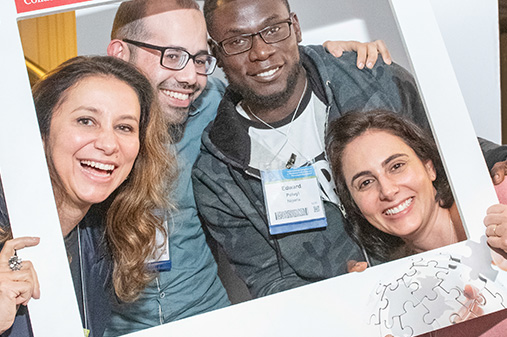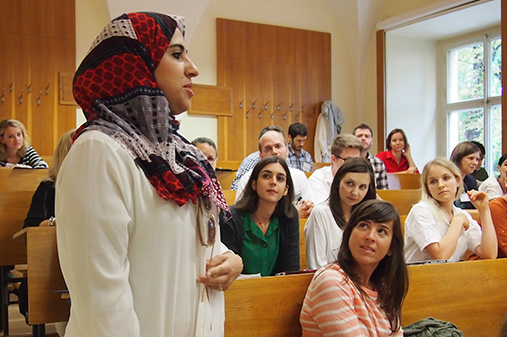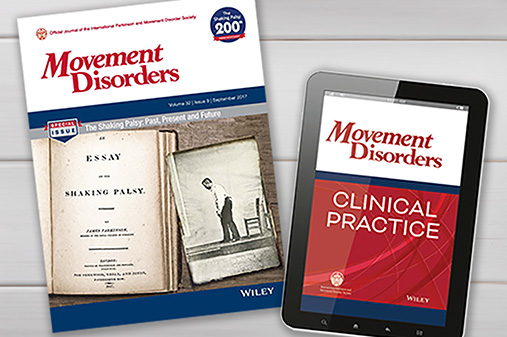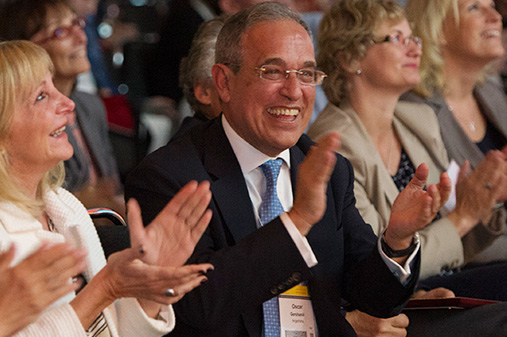Hematopoietic stem cell transplantation in CSF1R-related disorder
Journal CME is available until September 24, 2026
Read the article.
Dr. Hugo Morales Briceno: Welcome to today's episode of the MDS Podcast, the official International Parkinson and Disorder Society podcast. I'm your host, Hugo Morales, and today we will talk about all leukodystrophy due to dominant mutations in the colony stimulating factor one receptor or CSFR1 gene. Although there's no treatment for these conditions, some case studies suggest that hematopoetic stem cell transplantation or HSCT may modify disease progression.
View complete transcript
In this episode, we'll be discussing findings from an international cohort with CSFR1 patients treated with hematopoietic stem cell transplantations, published in the Movement Disorder Journal. To unpack the findings of this study, were joined by Dr. Fanny Mochel, from the Department of Medical Genetics Reference Center for Adult Leukodystrophies in Paris, [00:01:00] France. Welcome Dr. Mochel.
Prof. Fanny Mochel: Thank you very much. Very happy to be here with you today.
Dr. Hugo Morales Briceno: Thank you. Now I wonder if you could start by giving us a background on CSFR1 leukodystrophy. In particular with the possible pattern mechanisms that imply the condition and significance for any potential treatment.
Prof. Fanny Mochel: Yes. Although they are still prevalence studies being running in this condition, we estimate that CSF1R related leukodystrophy is likely the second most common leukodystrophy in adults. It's dominantly inherited, as you mentioned. The genetic can be complex because it has what we call it, an incomplete penetrance.
So not all carriers of pathogenic variants will develop the disease, but most a mutation that we know of have actually a high penetrance . And also there is complexity sometimes with some patients possibly carrying two mutations. And this [00:02:00] was also something outlined in our paper with childhood onset. But usually we are dealing with adult onset in this disease.
And again, with the complication of incomplete penetrance, but we think it's the second most common and the particularity that we have in this leukodystrophy compared to other leukodystrophy that we were more familiar with, like adrenoleukodystrophy or metachromatic leukodystrophy or Krabbe disease. Among the ones that we have approaches with treatment in particular is that CSF1R is almost exclusively expressed in the innate immune system, so the microphages and the microglia.
And so there is really a primary immune problem in this disease. We call it a microgliopathy. And therefore the logic to use hematopoietic stem cell transplantation was pretty obvious once the gene was discovered, because it's one of the latest one in the field especially if we consider it's prevalence.
And the [00:03:00] idea is that by replacing the microglia with this pathogenic variance with healthy microglia, either from related donors or unrelated donors but without this mutation that we can correct this ongoing neuroinflammatory process. And therefore halt this disease progression.
I must say that if we get into the pathophysiology, it's still unclear when it comes to this heterozygous variant, whether it's a loss of function, gain of function, it's still debated in the field, the precise mechanism. But, for sure when we replace with healthy microglia, we are able in theory, of course to rescue this deficits of the microglia and therefore how disease is progression.
And the mechanism of microglia in leukodystrophy is known in other leukodystrophy, the ones I mentioned before, especially adrenoleukodystrophy. But of course in a ALD we have pathogenic variants in other cell types and neurons in astrocytes, [00:04:00] oligos that we don't treat with the transplant. But here we have more or less, possibly a pure representation of microglia disease that we could potentially completely treat with this treatment. The main issue is when we intervene because they are early, very early, changes in the brain that can be completely undetected for many years. And even actually people who may never develop the disease have abnormal MRI pattern.
But when we get to detected, usually the symptoms are pretty advanced and with very striking atrophy. So the rescue there is of course much more challenging. Although it's a pure model of microgliopathy and therefore in theory, very accessible to a treatment that will replace the disease microglia.
Usually the stage where we diagnosis with the very advanced atrophy makes it a challenge to rescue. So, I think in this disease, the question of timing is very important, but first of all, we need to assess whether [00:05:00] the transplants was indeed a treatment of reference.
Dr. Hugo Morales Briceno: Yeah, and I understand that the study implicated collecting cases from different centers around the world, but I'm interested to know about the characteristics of the patients and what are the main outcome measures that were done for this patients and the prospective evaluation.
Prof. Fanny Mochel: Yeah, so the way it happened, we transplanted and reported one of the first patient for which this procedure was tested. That was back the first patient of ours was in 2016 and we published it in 2019. And it was already a patient with a very spastic, advanced spastic disease, but that fully stabilized and never develop cognitive alterations.
And from that report, there were small series, as you mentioned of two, three, largest one seven patients, but from originally one center with different [00:06:00] approaches but still with a lot of doubts in the field, including from patient association. There is, particularly in the US the Sister Hope Foundation and problems with reimbursement of the procedure.
Some countries I know, at least in Europe for Italy, for the Netherlands. In particular. Although there was evidence for the potential rescue by the transplant there was still a lot of pending questions and also, again, access to therapy that could be very challenging.
So since like a lot of rare diseases we work in networks we've been discussing a lot of our experience over the years, and it really came obvious to us that we needed to try to do something in a multicentric manner with different approach to to transplant as well.
Because in our paper, not everybody, for example received bone marrow. There were all the sources of hematopoietic stem cells that were also transplanted in the patients with different conditioning regimen as well. So we, this is also what we try to approach in this study.
But basically we. We [00:07:00] tried besides the reported case and especially the recently reported case to gather within our networks of reference center for leukodystrophy, what was our current experience? This is how we got to work with the reference center in Amsterdam, in the Netherlands, in Leipzig, in Germany, in Brazil patients also from Ireland and to begin also in Germany.
And this is how we basically collected or collective experience. But then this is obviously a retrospective study but as we usually do in this field, we collected as many outcomes that as we could. So clinically there is standard measures like the ADSS that at least has the advantage to be comparable regardless of the presenting disease for these patients.
But we also had, some cognitive assessment obviously, and especially in France, we had it very standardized. So this is what we tried to highlight a little bit because it was more quantitative over time. And also all of us had MRI that. We could [00:08:00] collect and scored because the, there was a report of trying to harmonize, even if it has limits, because it doesn't really measure the lesion load, it measures the regions affected by the disease, but it's not a volumetric, of course, scoring, but the sender score that we used as well.
As a marker for disease progression, radiologically, and also most centers collected plasma samples, so we were able to measure the neurofilament in the plasma. We know that there are reports in the CSF, but actually plasma is very sensitive to change, so that was good enough. And so we were also able and there have been reports that in, especially in some leukodystrophy, like a ALD, but also CSF one or related leukodystrophy, that it's very sensitive to onset of the disease.
So now the question was it also sensitive to treatment possibly. So we try to approach this from a clinical radiological and biological outcomes. But of course with the limit of a retrospective study and still some of course heterogeneous that dataset. So [00:09:00] that's why we try to harmonize.
But we try to grasp basically the different aspects with these three type of assessment.
Dr. Hugo Morales Briceno: And despite having a retrospective design, however with longitudinal data, so what are the main findings of the study? What did you see in terms of. The trajectories for these patients either in immediately after transplantation or follow up in six months or 12 months. So what is the trend for overall?
And if there are any specific signals or interesting signals in terms of response.
Prof. Fanny Mochel: Yeah. So first of all I think our cohort was relatively representative of what is known of the disease in the age of onset roughly the patients were in their forties. We had an important actually representation of patient with psychiatric and cognitive symptoms. More than 80% because it's been reported that the outcome can be different if patients present predominantly with moderate symptoms or cognitive psychiatric symptoms.
So in our cases, we had the broad [00:10:00] spectrum as well of motor symptoms, especially extrapyramidal, actually 60% of the patient, but also spasticity and some cerebral signs in about a third of patient. But the cognitive and psychiatric domain were affected, not too affected, of course, so that the transplant still could be performed because that's an issue to get the patient consent, obviously.
And so our observation again with different type of transplant procedures was that we definitely saw a progression of the disease in the first six months, six to twelve. Which I should say it's not a surprise in general when performing transplant in leukodystrophy. We do have a disease progression observed in patients with, I'm talking of course about adult here with adrenoleukodystrophy or metachromatic leukodystrophy if we do it when the symptoms are there, not of course, at a presymptomatic stage. So it was not so surprising. But it's definitely something that we could measure both on our clinical outcomes especially on the motor side, [00:11:00] actually. From the complication from the transplant, because it's obviously as we can imagine a heavy procedure, but also on the MRI, that's where we saw a progression of atrophy from this first year, but especially the first six months. But then we, as we actually initially published in our first patient we saw a full stabilization in the majority of the patient. A large majority actually. And to our surprise, and that is something to our knowledge, which is not so much reported in other leukodystrophies, and maybe because this one primarily affect the microglia, we actually saw some late improvement in some features.
So that was very striking. When it comes to something that is a bit peculiar in the disease, we have restricted diffusion lesions that actually disappeared over time. Even when we could have more quantitative MRI where we had especially 3D scanners where we can better assess the volume load of the lesions, we could actually see some reduction of [00:12:00] white matter lesions over time.
And more importantly, obviously we saw two, three sometime or years after transplant, some late improvement in cognition to the point that it was back to baseline or even better. And that is really striking especially when we consider the level of atrophy of this patient.
There is such a discrepancy. Between the MRI aspect and what can still be expected especially on in the cognitive domain for the patient that we transplanted at the earlier stage. So with really minimal symptom because of sometimes random detection on headaches, for example. For this patient we actually had full recovery.
That really also provides hope that if we can screen and detect very early this disease when there is onset, because again, not all the patients will present with symptoms because of the incomplete penetrance. We can hope really for even a full recovery. So that provides I think, a lot of hope.
And I guess the last important [00:13:00] message to us was, we also saw after the initial increase of NFL in some patients, also almost a return to normal levels actually. So another important markers that's on the pathophysiology. We are effectively replacing the affected cells.
But what was also an important message is that we may not need these fully myeloablative conditioning regimen and that some attenuated ones that are less toxic may actually also be considered, which can open transplant for more patients.
Dr. Hugo Morales Briceno: Fantastic. And for the design of future clinical trials, the studies in CSFR1 is, now that you mentioned that there's some options in terms of hematopoietic stem cell transplantation subtypes. Is this something relevant for screening more patients for this dominant CSFR1 mutations in demyelinating diseases?
With this view?
Prof. Fanny Mochel: Yeah. So the challenges that we face right now is that [00:14:00] unfortunately that transplant is for sure, first of all, not accessible everywhere in the world. As I mentioned, they also, even when countries that can do it sometimes issues with reimbursement, but we know that for, in some countries, obviously it's not even accessible and it's a heavy procedure. We lost two patients in our cohort. There is also a mortality rate that needs to be considered. There is a important problem of compatible donors. And for some patients it would be a problem.
And even if we can perform at a, regimen conditioning. Still there will be limit in the age at which we can transplant. After 60 years of old, it'll be probably not realistic. So there is definitely a need for other treatments and possibly of course, less with less toxicity. And for that fortunately recently we had the negative outcome in a trial that was trying to target the TREM two protein in the hope of rescuing some microglia function, but other approaches, obviously. And we learned from each trials that [00:15:00] trial was very important and we hope that there will be others also to to try to have another access to this cellular dysfunction.
But, for now, in terms of what we have which is the transplant, it's only by detecting early indeed that we will be able to not only maybe stabilize, but maybe help a patient to recover at this very early stages. And so we are trying to advocate as much as we can. Of course in your journal a lot, but a lot of colleagues around the world that any type of white matter abnormality that is not fitting the McDonald's criteria should be investigated for something else. And and in particular, again because it's so a typical compared to other leukodystrophy that are much more fascicular and with a symmetrical pattern. So this is why it can be misleading, but to always consider that this could be a rare disease that is treatable. And I think the patient association as well are doing an amazing work in this domain. But we need to [00:16:00] continue the effort. And I think also people working in the field of vascular encephalopathy, because there are some patterns on the MRI that are consistent as well are also now familiar with this people working in the field of dementia movement disorders as well, because as we heard, extrapyramidal features can be not only prominent, but they can be actually the first symptoms that patients present with. So message should be, you should always question yourself in front of a white matter abnormality. People tend to say, oh, it could be just inflammatory. Or maybe this is just vascular from hypertension, but there are many experts all around the world. So having a second opinion on MRI is really something that is possible.
And the yield of success in terms of changing the impact for the patient is huge. Not just for the patient, for the family as well.
Dr. Hugo Morales Briceno: This concludes today's episode, and I would like to thank Dr. Mochel again for providing valuable insights into the potential role HSCT and CSFR1 leukodystrophy. Stay tuned for our next episode where we will continue exploring the latest [00:17:00] developments in movement disorders. Until then, stay curious and keep learning.
Prof. Fanny Mochel: Thank you very much.
Dr. Hugo Morales Briceno: Thank you, Dr. Mochel. [00:18:00]

Fanny Mochel, MD, PhD
Pitie-Salpetriere Hospital, Sorbonne University
Paris Brain Institute (ICM)
Paris, France
